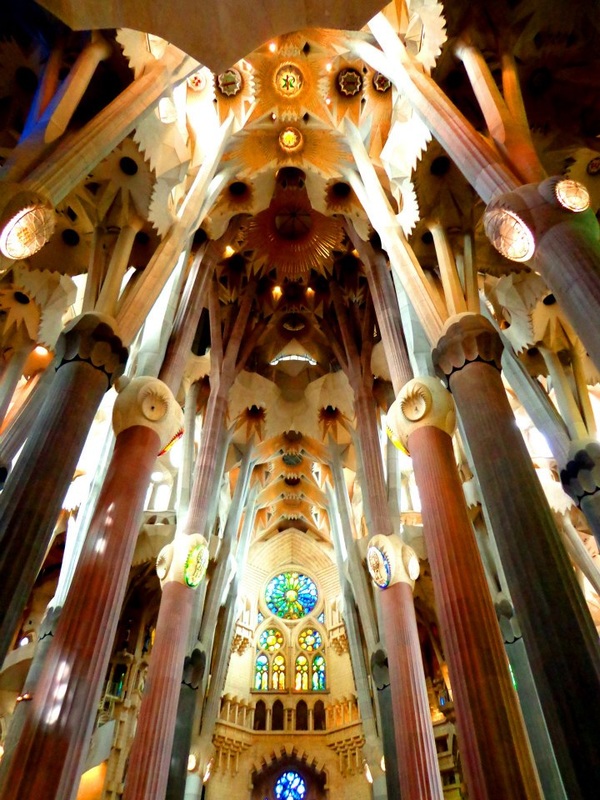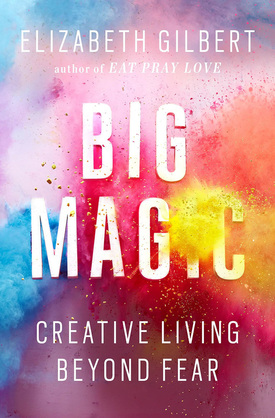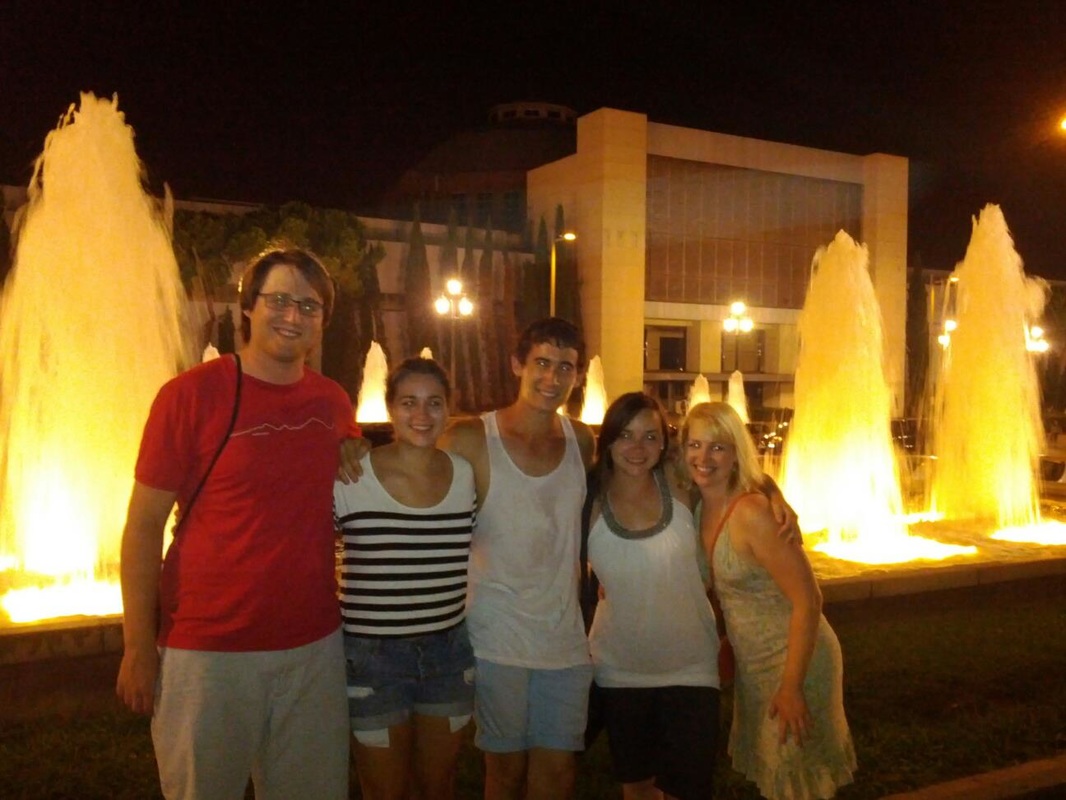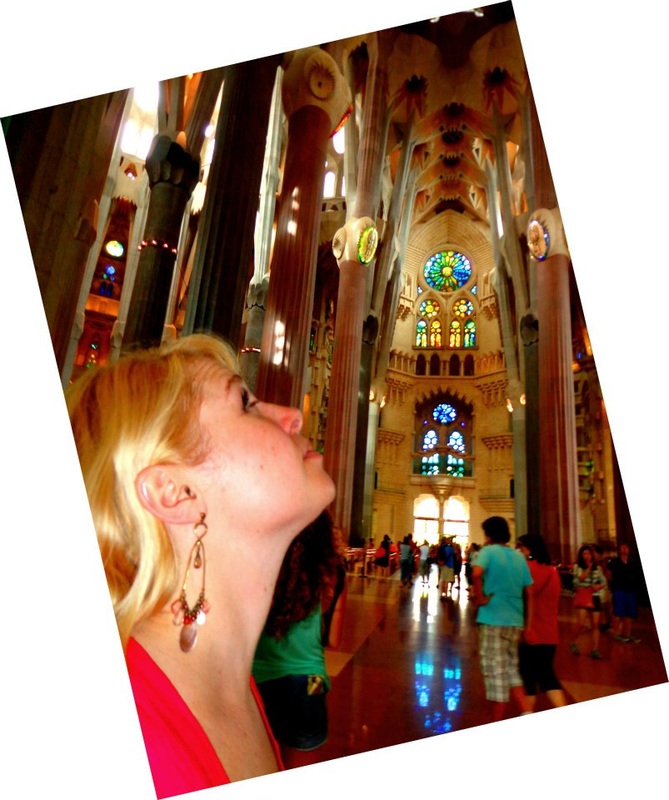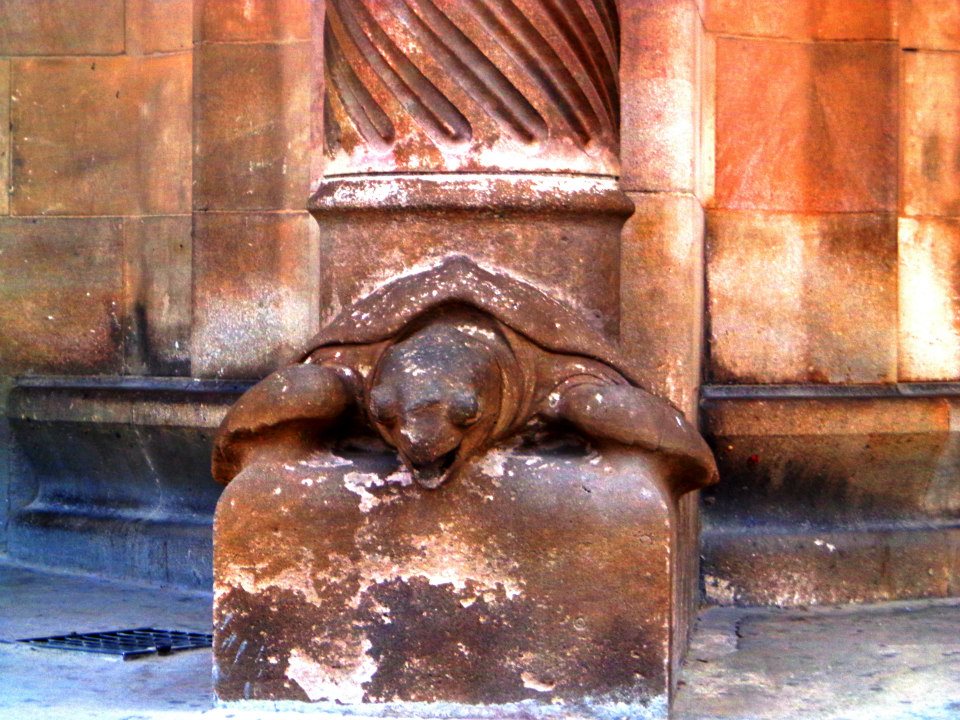Interior of Sagrada Familia
Have you ever felt inspired with a great idea?
How did it come to you?
The practice of meditation, as a part of yoga, is a tool to help us quiet our mind and tap into to the deep places of our consciousness that inspire creative ideas to emerge.
As described in the ancient Vedas and Upanishads of yoga philosophy, the universe expresses itself as spontaneous creative energy in the form of what we call Prana, the intelligent life force. When we practice awareness in asana (the physical postures), and pranayama (breathing techniques), we fuel the creative process by increasing and directing the flow of prana, through the energy channels in our body. Therefore, yoga allows us to open up to that passage, that connection with the divine.
We are reminded of our conscious movement connections each time we flow through Sun Salutations: Inhale, reach your arms up to the sky. Exhale, swan dive and forward fold. Inhale, halfway lift and exhale fold with your chin to your chest.
As described in the ancient Vedas and Upanishads of yoga philosophy, the universe expresses itself as spontaneous creative energy in the form of what we call Prana, the intelligent life force. When we practice awareness in asana (the physical postures), and pranayama (breathing techniques), we fuel the creative process by increasing and directing the flow of prana, through the energy channels in our body. Therefore, yoga allows us to open up to that passage, that connection with the divine.
We are reminded of our conscious movement connections each time we flow through Sun Salutations: Inhale, reach your arms up to the sky. Exhale, swan dive and forward fold. Inhale, halfway lift and exhale fold with your chin to your chest.
Inhale, step back into plank pose- one straight line with your body. Exhale, lower through Chaturanga.
Inhale to cobra, and exhale to Downward Facing Dog. Repeat and add on.
As we move our bodies, breathe, and focus, we allow divine energy to pass through us.
Sometimes this energy takes place in the form of ideas or inspiration. Some of us may be really open to receiving these great ideas. However, inspiration is only the starting point.
Sometimes this energy takes place in the form of ideas or inspiration. Some of us may be really open to receiving these great ideas. However, inspiration is only the starting point.
Have you ever received an idea for a creative work and found that you lacked the courage to complete it?
The creative journey is one in which we expose our souls to the world. Elizabeth Gilbert, author of Eat Pray Love, shares her relationship with creativity and fear in her latest book, Big Magic: Creative Living Beyond Fear, “The essential ingredients for creativity remain exactly the same for everybody: courage, enchantment, permission, persistence, trust—and those elements are universally accessible. Which does not mean that creative living is always easy; it merely means that creative living is always possible.”
I agree with Gilbert as she believes that we all have a creative side, even though our mediums and outlets vary from writing, painting, designing, engineering, cooking, dancing, singing, speaking, coding, baking, acting, or even bedazzling your ox. She remarks, “To even call somebody ‘a creative person’ is almost laughably redundant; creativity is the hallmark of our species. We have the senses for it; we have the curiosity for it; we have the opposable thumbs for it; we have the rhythm for it; we have the language and the excitement and the innate connection to divinity for it.”
I agree with Gilbert as she believes that we all have a creative side, even though our mediums and outlets vary from writing, painting, designing, engineering, cooking, dancing, singing, speaking, coding, baking, acting, or even bedazzling your ox. She remarks, “To even call somebody ‘a creative person’ is almost laughably redundant; creativity is the hallmark of our species. We have the senses for it; we have the curiosity for it; we have the opposable thumbs for it; we have the rhythm for it; we have the language and the excitement and the innate connection to divinity for it.”
“A creative life is driven more strongly by curiosity than by fear."
Liz Gilbert explains that fear is an essential part of our survival. If we were completely fearless, we would have no caution when jumping into a fire or off of buildings. However, we must realize the difference between when fear is working to protect us, or keeping us from living a fulfilling life. She emphasizes that it's less about fighting fear and more about working with it and around it. “Fear is always triggered by creativity, because creativity asks you to enter into realms of uncertain outcome. This is nothing to be ashamed of. It is, however, something to be dealt with.” As Liz states, “A creative life is driven more strongly by curiosity than by fear…Fear is a desolate boneyard where our dreams go to desiccate in the hot sun.”
In order for the creative energy to manifest as a work of sculpture, poetry, or musical composition, artists need to be able to focus intensely on their work for hours at a time. The deeper practices of yoga, including dharana (deep concentration) and dhyana (sense of oneness), are particularly powerful for training us to access, and remain in, a focused state of creative flow. Our art-making helps us become more present in our daily lives and offers us an opportunity to connect more deeply with the universal creative force that resides in us all.
“The brave alone enjoy the world.” - Swami Rama
This book has been monumentally inspiring for me in my writing of this blog and upcoming yoga philosophy/travel memoir books. Liz Gilbert encourages me to keep writing, painting, exploring, and creating in many other forms, like my yoga sequences and playlists, because it brings fulfillment and purpose to my life. Swami Rama speaks this truth in one of my favorite quotes, “The brave alone enjoy the world.” We shouldn’t put the pressure of “making a living” off of our art, but if the Universe wants that to happen for us, then it certainly can. Just as I am still plugging away as a writer, teacher, and food server, Liz Gilbert didn’t quit her bartending and food serving jobs until she produced her fifth book, and reached the best seller list with Eat Pray Love, selling over 10 million copies. Since then, she has been named amongst Time 100 most influential people in the world by TIME magazine.
Check out my colorful big magic inspired yoga leggings!
Do you believe in the power of your thoughts and attitude?
Last week I held a book discussion, for Big Magic, with some of my dearest friends who also explore their depths of creativity. We discussed the power of our thoughts.
“Every time you express a complaint about how difficult and tiresome it is to be creative, inspiration takes another step away from you.” When we experience judgment or perfectionism or self-criticism, it’s just another thing to notice. If we notice it, it starts to lose its power.
Former dolphin trainer and now nanny and world traveler, Sara Martinez felt influenced by the concept that if you don't "give your mind a job to do then it will invent a job itself that you may not like. Sara shared, “when my mind is not actively creating I find it telling me all the things I should have done, should be doing or focusing on mistakes that I have made. In Gilbert's words I am actively destroying instead of actively creating.”
“Every time you express a complaint about how difficult and tiresome it is to be creative, inspiration takes another step away from you.” When we experience judgment or perfectionism or self-criticism, it’s just another thing to notice. If we notice it, it starts to lose its power.
Former dolphin trainer and now nanny and world traveler, Sara Martinez felt influenced by the concept that if you don't "give your mind a job to do then it will invent a job itself that you may not like. Sara shared, “when my mind is not actively creating I find it telling me all the things I should have done, should be doing or focusing on mistakes that I have made. In Gilbert's words I am actively destroying instead of actively creating.”
"We need more creation, not more destruction.”
Sara Martinez
In our culture, we sometimes run into a tortured artist stereotype: someone who experienced pain and starting creating artwork reflecting that pain; however, the more and more we feed our dark side, the larger it grows. Devoted writer, jewelry designer, fashionista, and interior designer, Alexis Burns empathisizes. “I have witnessed many a tortured artist. I believe that their torment has fed their art… Sadly, some artists thrive on pain. It is all they know.”
Gilbert states, “A lot of what I'm doing in this book is really questioning whether we need to continue the myth of the tortured artist. A lot of artists are distrustful of pleasure, and really trust only the darkest parts of being authentic. That leads to a lot of misery and self-destruction… Insanity is a very tempting path for artists, but we don’t need any more of that in the world at the moment, so please resist your call to insanity. We need more creation, not more destruction.”
Spanish teacher, JoAnna George explores international cultures and artifacts as she recreates visual and audible artworks with her K-8th grade students. She expanded further on this topic when she said, “Sometimes we will suffer when a tragedy, death, or other alienation occurs in our lifetime. We may feel the need to express this feeling of humanity and may go on to create wonderful masterpieces of art.” For example, following Picasso's Blue Period, depicting themes of poverty, loneliness, and despair in somber tones of daunting blues, Picasso's Rose Period represents more playful themes of clowns, tricksters, carnival performers, depicted in cheerful vivid hues of red, orange, pink and earth tones. Based largely on intuition rather than direct observation, Picasso's Rose Period marks the beginning of tPicasso's experiments with what is simple and unsophisticated. However, JoAnna also agrees with Gilbert when she states, “But, I don't believe they should rely on that torment to continue creating art.”
Liz Gilbert also expresses the idea that nothing is nor should be perfect. We should explore creativity like a trickster or magician, with a playful and experimental approach. Sara Martinez furthered on this topic when she realized, “In the past couple of years I have tried my best to omit the word ‘perfect’ in my dialogue. Omitting that word to me does not come from an idea of perfection but more reminds me that it's ok for things/people/myself to have faults...that to me is a more realistic idea of how to live life.” When we are afraid that we need to be perfect, then we lose the courage to “go for it” when we have an idea.
Let’s start saying, Yeah, I'll do that. I'm ready. If not me, who? Likewise, if you are serious about a life of creative expression, then you should take on this work like a holy calling. Cleaning ourselves up, practicing yoga postures, breathing deeply and concentration are effective ways to continue to let inspiration flow through you. Liz talks about dressing up for creativity as well.
When Elizabeth thought that she was out of inspiration, she started gardening, creating life in a new way. This inspired her curiosity about where all of these different seeds come from and she began research on life as a botanist in the 1800s, which led to her amazing novel, The Signature of All Things.
Let’s start saying, Yeah, I'll do that. I'm ready. If not me, who? Likewise, if you are serious about a life of creative expression, then you should take on this work like a holy calling. Cleaning ourselves up, practicing yoga postures, breathing deeply and concentration are effective ways to continue to let inspiration flow through you. Liz talks about dressing up for creativity as well.
When Elizabeth thought that she was out of inspiration, she started gardening, creating life in a new way. This inspired her curiosity about where all of these different seeds come from and she began research on life as a botanist in the 1800s, which led to her amazing novel, The Signature of All Things.
Why is this book about creativity called Big Magic?
There’s a very unique scene in the book, that gives me goosebumps, about Elizabeth’s philosophy of ideas as they float around in space looking for someone to accept them and try to implement them. I don’t want to give away the spoiler details of this intense awakening, but I will say that magic is fascinating, captivating, charming, glamorous, enchanting, entrancing, and magnetic.
It relates to the art of producing illusions. Visual art is surrounded with producing illusions when it comes to shading, linear perspective, spacious architectural design, artificial color, etc. Magic also refers to the power of apparently influencing the course of events by using mysterious or supernatural means. In this sense, when we speak of energies or the life force energy of Prana, this could be considered a supernatural means that inspires us to produce and create.
The universal language of inspiration speaks of being struck by lightning, an idea coming to you while waking up in the middle of the night, with chills on your arms. Tammy Spencer Towner had this precise type of inspiration when she began devoting her energy to TS Jewelry Designs. She literally felt struck by intense ideas about new designs, during a transitional part of her life, while she was sleeping. This period of her life allowed her to step away from her routine and see in a new way.
Now her jewelry is featured at Café Chloe, Mingei International Museum store, Lux Institute and other boutiques around California. She draws inspiration design from Ancient Egypt, Turkey, and the Caribbean. She is currently exploring opportunities to expand her sales in Italy as well. Tammy Towner added, “I love the power of positive thinking, which I feel in this book, and it allows my mind to go deep with possibilities.”
It relates to the art of producing illusions. Visual art is surrounded with producing illusions when it comes to shading, linear perspective, spacious architectural design, artificial color, etc. Magic also refers to the power of apparently influencing the course of events by using mysterious or supernatural means. In this sense, when we speak of energies or the life force energy of Prana, this could be considered a supernatural means that inspires us to produce and create.
The universal language of inspiration speaks of being struck by lightning, an idea coming to you while waking up in the middle of the night, with chills on your arms. Tammy Spencer Towner had this precise type of inspiration when she began devoting her energy to TS Jewelry Designs. She literally felt struck by intense ideas about new designs, during a transitional part of her life, while she was sleeping. This period of her life allowed her to step away from her routine and see in a new way.
Now her jewelry is featured at Café Chloe, Mingei International Museum store, Lux Institute and other boutiques around California. She draws inspiration design from Ancient Egypt, Turkey, and the Caribbean. She is currently exploring opportunities to expand her sales in Italy as well. Tammy Towner added, “I love the power of positive thinking, which I feel in this book, and it allows my mind to go deep with possibilities.”
When I think of Big Magic on my travels, I’m reminded of the city of Barcelona.
Is it a coincidence that located near the center of the city lies the Magic Fountain of Montjuïc? Built in 1929 for the International Exhibition, this fountain offers a spectacular display of music, water acrobatics and lights which generate over 50 kinds of shades and hues. In 2012, I felt the entrancing affect of these dancing fountains as I also felt a magnetic draw to these interesting people in my hostel. We explored parts of this city together with a new sense of fascination.
Barcelona is bursting with color, shapes, movement, balance, inspiring forms, and variety, thanks to the world renowned Art Nouveau architect, Antoni Gaudi. The work of Antoni Gaudí represents an exceptional creative contribution to the development of architecture and building technology in the late 19th and early 20th centuries. In Barcelona, six out of eight World Heritage UNESCO Sites were designed by Antoni Gaudi.
Gaudí's work was uniquely influenced by his passions for nature and devotion to the Divine. In yoga philosophy, the time spent studying nature through concentration and meditation is known as Dharana and this devotion to the divine is known as Dhyana. He is a marvelous example of someone who excelled beyond fear. He kept his channels open to inspiration and never stopped producing art of intense exceptionality.
During his time as a student, Gaudí was able to study a collection of photographs of Egyptian, Indian, Persian, Mayan, Chinese and Japanese art owned by the School of Architecture. His work transcended mainstream Art Nouveau, with in a curvilinear organic style inspired by natural forms. In some buildings, it looks like he didn’t even use any straight lines. Everything that he created looked like it was coming to life.
Casa Batlló’s rooftop is arched and similar to the back of a dragon or dinosaur. The local name for the building is Casa dels ossos (House of Bones) because it has a skeletal organic quality. Featuring irregular oval windows and flowing sculpted stone work, much of the façade is decorated with a mosaic made of broken ceramic tiles, trencadís, that starts in shades of golden orange moving into greenish blues.
Gaudí's work was uniquely influenced by his passions for nature and devotion to the Divine. In yoga philosophy, the time spent studying nature through concentration and meditation is known as Dharana and this devotion to the divine is known as Dhyana. He is a marvelous example of someone who excelled beyond fear. He kept his channels open to inspiration and never stopped producing art of intense exceptionality.
During his time as a student, Gaudí was able to study a collection of photographs of Egyptian, Indian, Persian, Mayan, Chinese and Japanese art owned by the School of Architecture. His work transcended mainstream Art Nouveau, with in a curvilinear organic style inspired by natural forms. In some buildings, it looks like he didn’t even use any straight lines. Everything that he created looked like it was coming to life.
Casa Batlló’s rooftop is arched and similar to the back of a dragon or dinosaur. The local name for the building is Casa dels ossos (House of Bones) because it has a skeletal organic quality. Featuring irregular oval windows and flowing sculpted stone work, much of the façade is decorated with a mosaic made of broken ceramic tiles, trencadís, that starts in shades of golden orange moving into greenish blues.
His best-known work is the immense but still unfinished church of the Sagrada Família, which has been under construction since 1882, and is still financed by private donations. The Sagrada Familia is the world-wide symbol of Barcelona. The monumental church El Temple Expiatori de la Sagrada Família (Expiatory Temple of the Sacred Family) is Gaudi's most famous work and the finest example of his visionary genius.
It takes visitors into a spiritual atmosphere thanks to the arrangement of the light sources and the colors of the windows. Inspiration from nature is taken from a tree, as the pillar and branches symbolize trees rising up to the roof. Gaudi dedicated his life to carrying out this ambitious undertaking which due to his sudden death was left unfinished. The project was resumed in 1952 using drawings and scale models. As of 2007, completion is planned for 2026.
It takes visitors into a spiritual atmosphere thanks to the arrangement of the light sources and the colors of the windows. Inspiration from nature is taken from a tree, as the pillar and branches symbolize trees rising up to the roof. Gaudi dedicated his life to carrying out this ambitious undertaking which due to his sudden death was left unfinished. The project was resumed in 1952 using drawings and scale models. As of 2007, completion is planned for 2026.
Further, Gaudi’s Park Guell is one of the most impressive public parks in the world. This public park system is composed of gardens and architectonic elements that incorporates a network of twisting roads, which follow the contours of the land. Although considered to be a serious person, Gaudi is also a trickster as he created a playground for the mind with visual jokes, like columns that simulate palm-tree trunks and quilts of ceramic tiles.
His dragon salamander fountain in the center represents the element of fire and transformative qualities of materials. Throughout this park, he introduced new techniques in the treatment of materials, such as trencadís which used broken waste ceramic pieces, teaching us to recycle and repurpose objects. The focal point of the park is the main terrace, surrounded by a long bench in the form of a sea serpent. The curves of the serpent bench form a number of enclaves, creating a more social atmosphere.
His dragon salamander fountain in the center represents the element of fire and transformative qualities of materials. Throughout this park, he introduced new techniques in the treatment of materials, such as trencadís which used broken waste ceramic pieces, teaching us to recycle and repurpose objects. The focal point of the park is the main terrace, surrounded by a long bench in the form of a sea serpent. The curves of the serpent bench form a number of enclaves, creating a more social atmosphere.
“Architecture is the arrangement of light; sculpture is the play on light.”
Casa Milà is an example of Gaudi’s use of light and quality of positivity over darkness. Every room of the house has skylights of varying size that allows them all to have natural light, so that almost every part of the house gets its share of sunlight. Gaudi states, “Architecture is the arrangement of light; sculpture is the play on light.” This creation has an interesting rooftop with a large ensemble of twenty-eight different surrealistic chimneys in several groupings, twisted so that the smoke comes out more effectively. One of the chimneys was topped with glass pieces; it was said that Gaudí used this mosaic technique the day after the inauguration of the building, taking advantage of the empty bottles from the party.
Elizabeth Gilbert profoundly declares,
“The universe buries strange jewels deep within us all, and then stands back to see if we can find them…Do you have the courage to bring forth the treasures that are hidden within you?”
What are your current creative goals?
What are you curious about? Where are you currently turning to for inspiration?
Please share your thoughts in the comments section below.
“The universe buries strange jewels deep within us all, and then stands back to see if we can find them…Do you have the courage to bring forth the treasures that are hidden within you?”
What are your current creative goals?
What are you curious about? Where are you currently turning to for inspiration?
Please share your thoughts in the comments section below.
